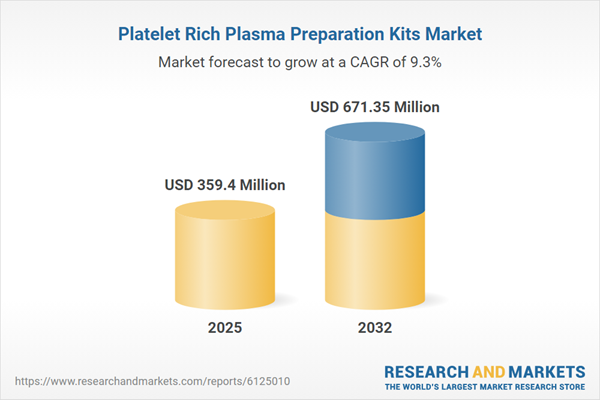Speak directly to the analyst to clarify any post sales queries you may have.
Platelet rich plasma preparation kits are transforming regenerative therapies, enabling healthcare providers to deliver patient-centric treatments with superior efficiency and reliability. The market is evolving rapidly due to rising demand for biologically enhanced solutions and continuous innovation in kit design and automation.
Market Snapshot: Platelet Rich Plasma Preparation Kits Market
The global platelet rich plasma preparation kits market grew from USD 329.93 million in 2024 to USD 359.40 million in 2025. With an anticipated CAGR of 9.28%, the sector is forecast to reach USD 671.35 million by 2032. This trajectory highlights the market’s robust momentum as technologies mature and new clinical indications drive usage across key healthcare settings. Accelerated adoption among hospitals, clinics, and specialty centers is fueling heightened competitive activity and intensifying supplier innovation.
Comprehensive Scope & Strategic Segmentation
This market research delivers a granular analysis of the platelet rich plasma preparation kits market, including detailed segmentation by product type, concentration output, kit design, application, end-user, and region.
- Product Types: PRP with Fibrin Matrix (PRF) Kits, Specialty PRP Kits (Leukocyte-Poor PRP (LP-PRP) Kits, Leukocyte-Rich PRP (LR-PRP) Kits), Standard PRP Kits (Double-Spin Kits, Single-Spin Kits).
- Platelet Concentration Output: High Concentration PRP Kits (>6× baseline), Medium Concentration PRP Kits (4-6× baseline), Low Concentration PRP Kits (2-4× baseline).
- Kit Type: Automated Kits, Manual Kits.
- Application Areas: Dentistry (bone grafting, dental implants, oral & maxillofacial surgery, periodontal regeneration), Dermatology & Aesthetics (facial rejuvenation, hair restoration, hyperpigmentation treatment), Orthopedics & Sports Medicine (cartilage regeneration, osteoarthritis treatment, tendon & ligament repair), Wound Healing (chronic ulcers, diabetic wounds, post-surgical recovery, pressure sores).
- End-Users: Ambulatory Surgical Centers (ASCs), Dermatology & Aesthetic Centers, Hospitals & Clinics, Research Institutes.
- Global Regions: Americas (United States, Canada, Mexico, Brazil, Argentina, Chile, Colombia, Peru), Europe, Middle East, and Africa (United Kingdom, Germany, France, Russia, Italy, Spain, Netherlands, Sweden, Poland, Switzerland, United Arab Emirates, Saudi Arabia, Qatar, Turkey, Israel, South Africa, Nigeria, Egypt, Kenya), Asia-Pacific (China, India, Japan, Australia, South Korea, Indonesia, Thailand, Malaysia, Singapore, Taiwan).
Key Takeaways for Senior Decision-Makers
- Technological progress, such as advanced centrifugation and point-of-care automation, is reducing procedural variability while supporting more consistent patient outcomes.
- Demand is intensifying for customizable kit formats, empowering clinicians to tailor platelet concentrations for applications in wound healing, orthopedics, aesthetics, and dental procedures.
- Adoption of digital health and data integration is enabling real-time procedural monitoring and building a stronger evidence base for regulatory approval and reimbursement.
- Manufacturers are investing in nearshoring and dual-sourcing to strengthen supply chain resilience in response to external pressures, including tariffs and international logistics challenges.
- Strategic partnerships across manufacturing, diagnostics, and analytics are enhancing product reliability and accelerating the development of application-specific protocols.
Tariff Impact & Supply Chain Strategies
Newly implemented U.S. tariffs on critical kit components are effecting sourcing and cost structures across the industry. Suppliers are prioritizing the establishment of regional assembly lines and expanding alliances with logistics providers. These measures help maintain pricing competitiveness and secure inventory reliability, though some price pressure persists on entry-level offerings. To address these challenges, companies are innovating with packaging redesigns and volume consolidation, without compromising product quality.
Methodology & Data Sources
This market research integrates primary interviews with clinicians, decision-makers, and procurement experts with in-depth secondary analysis of regulatory filings, scientific publications, and distributor feedback. Stringent validation and data triangulation ensure accuracy and relevance across regional and application domains. Independent industry experts have reviewed the resulting synthesis to uphold quality standards.
Why This Report Matters for Market Leaders
- Facilitates confident investment and procurement decisions by delivering unrivaled segmentation and actionable insights into evolving clinical and operational priorities.
- Equips executives to navigate complex supply and regulatory considerations with clarity on near-term challenges and emerging growth opportunities.
- Supports the alignment of product development, commercial strategy, and partnership initiatives for maximum long-term stakeholder value.
Conclusion
The platelet rich plasma preparation kits market presents dynamic opportunities as innovation, clinical adoption, and global distribution converge. Decision-makers will benefit from aligning strategic investments with advances in automation, customization, and partnership-driven product development to remain competitive and realize growth potential.
Table of Contents
3. Executive Summary
4. Market Overview
7. Cumulative Impact of Artificial Intelligence 2025
Companies Mentioned
The companies profiled in this Platelet Rich Plasma Preparation Kits market report include:- Alocuro Pty Ltd
- Arthrex, Inc.
- Becton Dickinson and Company
- Dr. PRP USA LLC
- Hubei Langtai Biotechnology Co., Ltd.
- Juventix Regenerative Medical LLC
- ProGen Labs LLC by Crown Laboratories, Inc.
- PRP PURE
- Regen Lab SA
- Shandong Weigao Group Medical Polymer Company Limited
- Stryker Corporation
- Zimmer Biomet Holdings, Inc.
Table Information
| Report Attribute | Details |
|---|---|
| No. of Pages | 181 |
| Published | November 2025 |
| Forecast Period | 2025 - 2032 |
| Estimated Market Value ( USD | $ 359.4 Million |
| Forecasted Market Value ( USD | $ 671.35 Million |
| Compound Annual Growth Rate | 9.2% |
| Regions Covered | Global |
| No. of Companies Mentioned | 13 |









